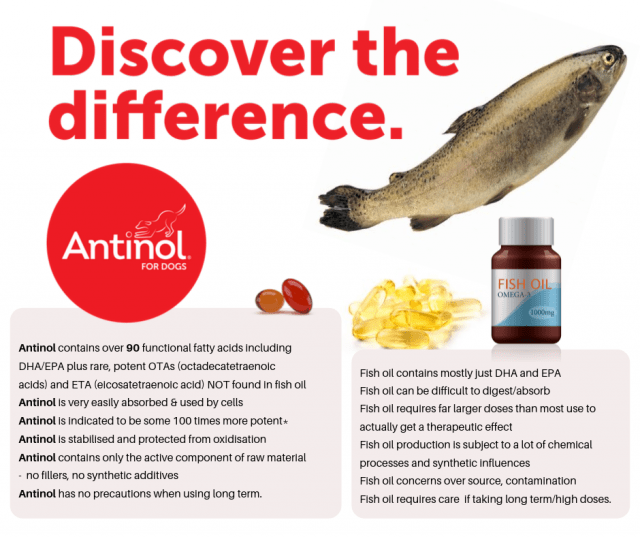The Difference between Antinol vs Fish Oils
When it comes to marine based Omega Supplements you know your dog should take them but do you know what to look for?
Getting stable, pure lipid oils extracted from a fresh marine source at a potency that can deliver a therapeutic result costs money. It isn’t cheap and cannot be done cheaply without compromising on the end product. In this It really is an area that you get what you pay for.
Today we will look at Antinol versus Fish oil and why they should never be compared.
ANTINOL
⭕️ Over 90 Functional Fatty Acids not just DHA/EPA but the complete spectrum of Omegas including rare and potent ETA and OTAs and Furan Fatty Acids.
⭕️ Supercritical fluid extraction of oil, solvent free.
⭕️ Therapeutic dose is indicated to be some 100 times more potent* – much smaller and results in under 14 days
⭕️ Highly bioavailable and used at cellular level. Metabolised differently to fish oil
⭕️ Purity of sourcing exclusive to Antinol, clean/unpolluted waters of NZ and speed of processing – from harvest to stabilisation in under 12 hours.
⭕️ Stabilised, purity tested, no synthetic excipients, no fillers, no oxidisation issues, no salt, no GMO’s, no toxins, unbleached/natural
⭕️ Safe for long term use, able to be used in conjunction with prescription medicine, does not impact blood clotting and does not require any Vitamin E supplementation
*when compared to standard fish oil containing standard EPA (18%) and DHA (12%) omega-3 fatty acid blend in ethyl ester form.
FISH OIL
❌ Fish oil contains largely only 2 Omega 3 fatty acids – DHA and EPA
❌ Chemically manipulated, distilled processing = Ethyl Ester (most fish oils available at the chemist are EE or 18/12 – contain 1000mg EPA 180mg and 120mg DHA)
❌Triglyceride form of Fish oil is better = bound fatty acid form but still requires numerous metabolic processes before it’s available for use.
❌ Need to take much larger doses to get therapeutic effect and results generally take in excess of 4 weeks
❌Can be hard for the good components to get absorbed in a stomach acidic environment – oil can rise to the surface and possibly cause indigestion, diarrhoea and burps.
❌ Source and purity questions and high potential for oxidisation, solvents, heavy metals, synthetic excipients, bleached for cosmetic appearance, use of enteric coatings
❌Clinical warnings on fat content impact if dosing at recommended levels over long term and question of blood thinning and vitamin E requirements
The variables are wide between brands and if you choose to use Fish oil it’s very important to open up a conversation with the manufacturer – especially when fish oil is marketed for human consumption.

Things to check:
- Is there a certificate of analysis on purity and oxidisation level?
- Any data on potency/efficacy or published evidence that is specific to their product not just the nutrients it contains?
- Where exactly is it sourced (not packaged)?
- Do they have any testing with regards to canine dosage? / canine use? Remember a dog’s digestive system is different to a human.
Also bear in mind:
Oxidisation commences the moment you open the bottle/jar regardless of expiry date labelled– so value/bulk packs are not optimal.
Check for preservatives like sulphites and be aware there may be sensitivities that can increase over time/continued use – for example Vitamin B1 deficiency can occur as sulphites can inactivate B1.
There is an argument that you could give your dog Antinol every second or third day and have a better intake of functional Omega 3 fatty acids than you would giving daily fish oil.









